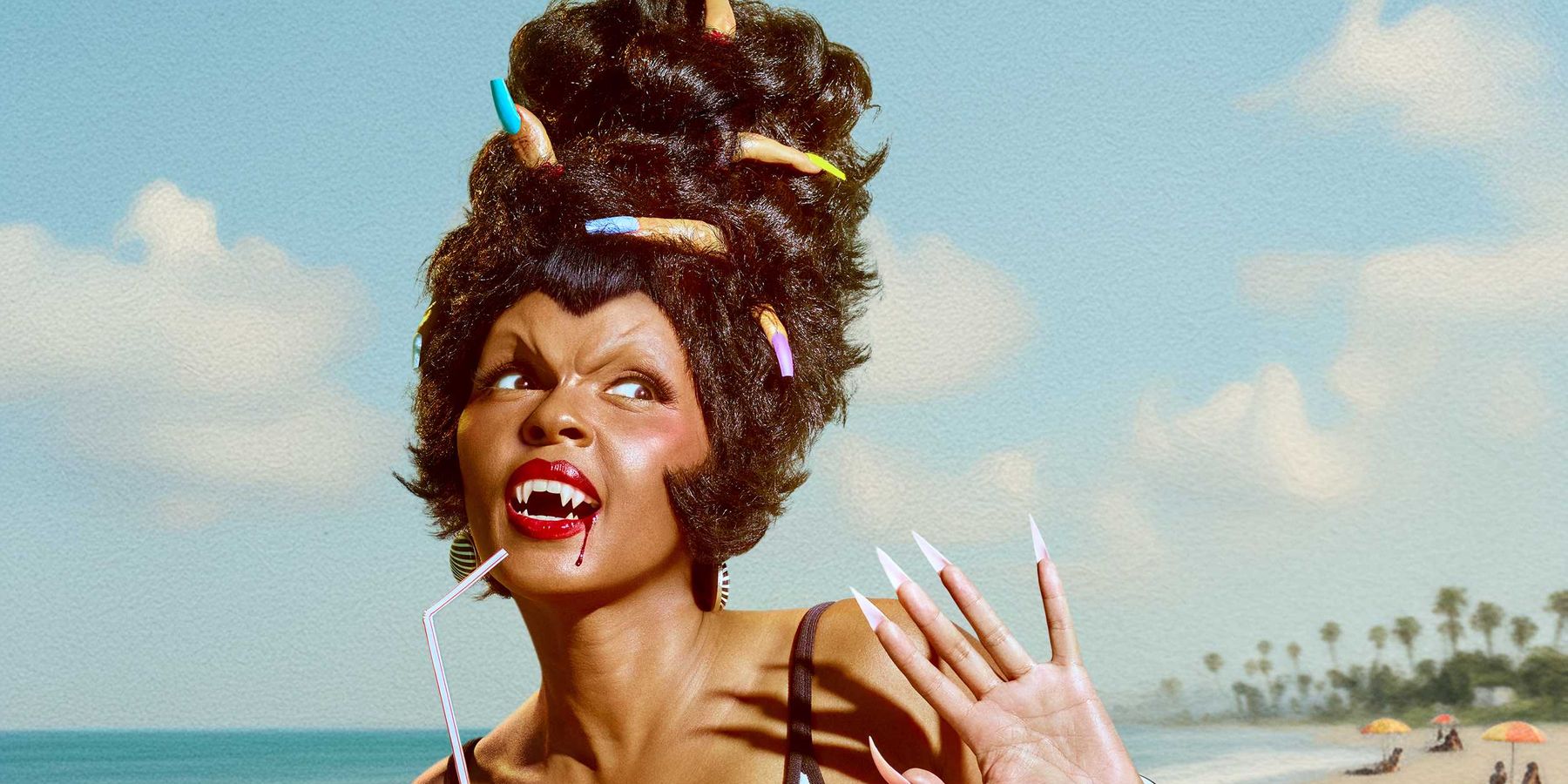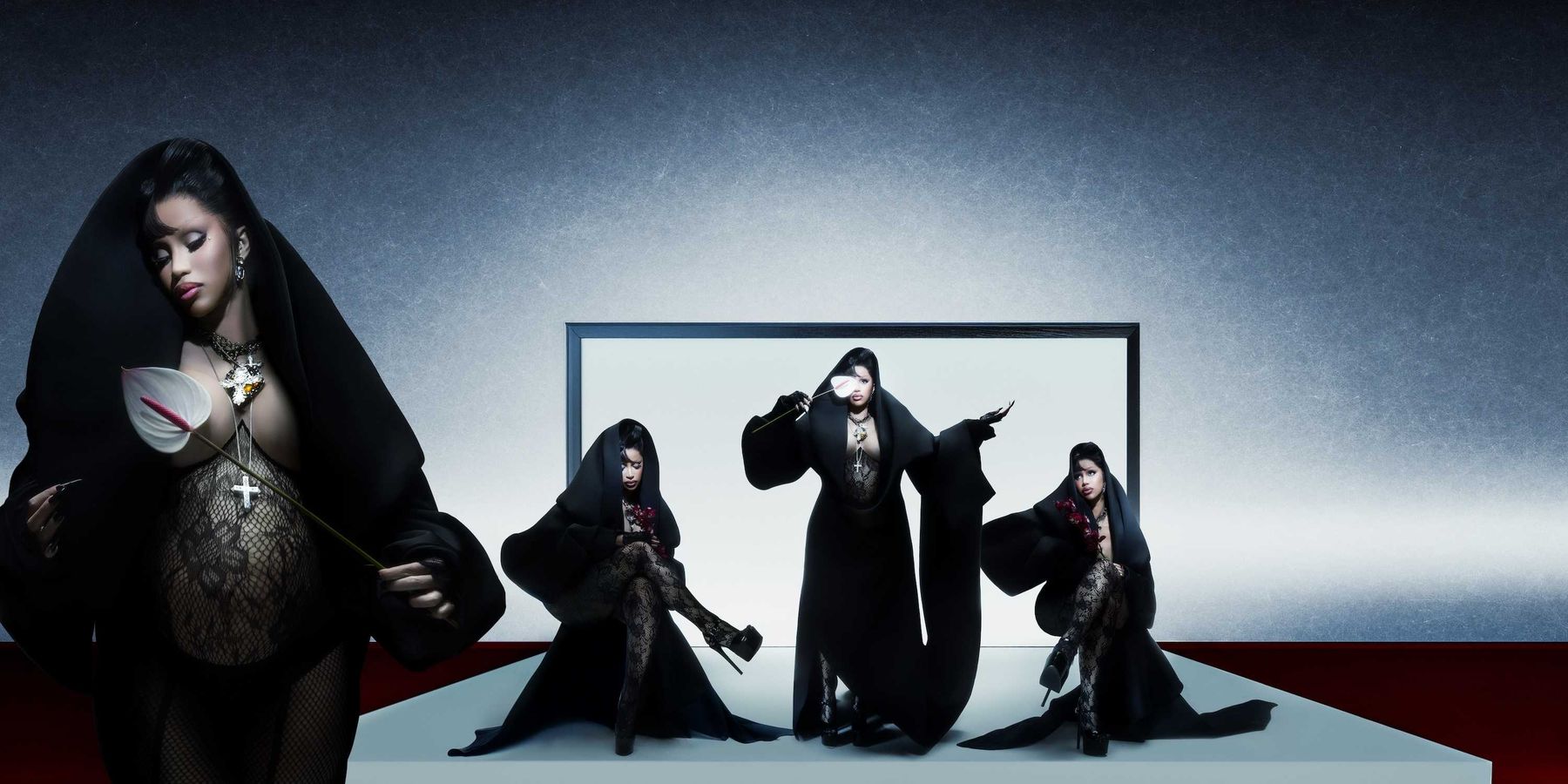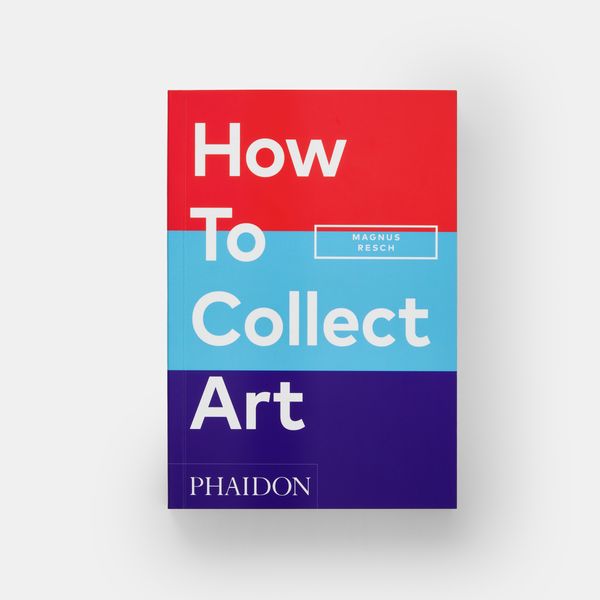
Where to Start Collecting Art
Jan 24, 2024
How to Collect Art is the definitive guide to the art market and collecting in the 21st century. Written by the world’s leading art-market economist and best-selling author Magnus Resch it outlines indispensable insight into key aspects of contemporary art collecting. He addresses essential questions, such as: What artists should I invest in? Where do I start? Which gallery should I visit? Is this price fair? Where’s the best place to sell my art? With the inner works of the art world laid out in an accessible manner at an accessible price, How to Collect Art is a portable — and affordable — art advisor in your pocket. Exclusive for PAPER, here's an excerpt from the introduction of How To Collect Art.
So, you want to buy your first piece and don’t want to spend a lot of money on it — where do you start? Where — from the twenty thousand galleries, two thousand auction houses, unlimited online art marketplaces, thousands of artworks available at art fairs, and millions of artists with Instagram accounts showcasing their art — do you buy your first piece?
Filtering this exhausting choice down to a manageable size is a challenge that every art collector has faced at some point. For this book I asked over 200 of the most prominent art collectors for their thoughts on where to start. They all said the same two things: See as much art as you can.Talk to as many gallerists, artists, collectors, and journalists as you can.
To give you an easy introduction, I summarize below the key institutions. We will go much deeper into each of them in later chapters in the book, so you will get a better understanding of where to buy and what to look out for. But let’s take this overview as a starting point:
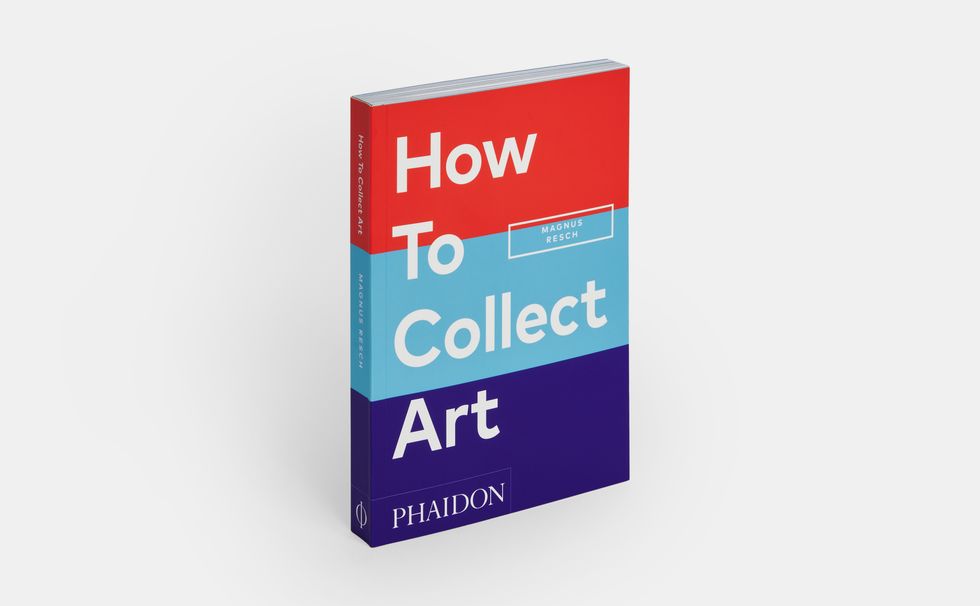
Galleries
Galleries are the best resource for seeing art. The best way to start going to them is to make a social event of it with friends and go to openings. They are usually on Thursdays from 6:00–8:00 p.m. Often, galleries team up and group their openings on the same day. We’ll return to this in a later chapter, when I will give you some tools to help you find galleries and their openings.
Gallery openings also let you widen your network. When I moved to New York City 10 years ago, I went to four hundred galleries in a month purely to rub shoulders and get an idea of New York’s local art world. From a starting point of literally no acquaintances, persistent self-introduction was leading to the beginnings of a network by the second Thursday, and gradually, I built a New York network that now includes curators, dealers, and artists. Generally, of course, buyers who are not art professionals won’t be able to put in that kind of time and may live in a city with considerably fewer galleries. The point I wanted to make, and make early and probably repeatedly to quash any hope that there may be shortcuts, is that buying art requires dedication. It means putting the effort in and going to see it. You will need to leave your house and visit art galleries.
Once you have found a list of gallery openings in your city (use the app seesawmap.com to see all openings in your city) you will need to decide which to attend, assuming you don’t have time to see all of them. In the chapter “Galleries,” I talk about exactly this: how to filter galleries and categorize them so you know where to go.
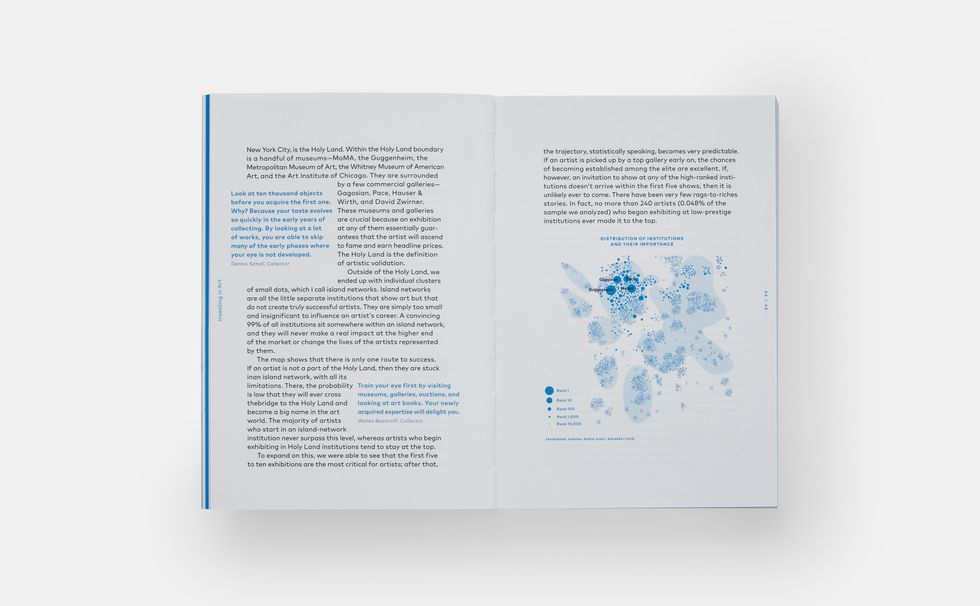
Online Platforms
Among the many online art platforms to search for and purchase art, the best is probably on your phone. Instagram is by far the best resource to find art. Use Instagram and follow the galleries and artists you like. Scroll through their profiles and see what they are showing. A good starting point is to follow the accounts of galleries in your city. The often detested social-media algorithm is your friend here: it will recommend further galleries or artists. Once you have found something you like, DM the gallery via Instagram to ask about the price. Gallerists and artists get these requests all the time, and they expect them, so don’t be scared to do it.
Over the last ten years, several online platforms for buying art have emerged, but the two principal types are galleries and the artist. Gallery platforms partner with physical galleries and display artworks from all the associated galleries on the one platform, with obvious all-in-one-place advantages for the potential buyer. The most prominent is artsy.net, an alternative is platformart.com. Artist platforms are websites where you can buy direct from artists, circumventing galleries and thus often spending less, as artists do not need to price in a representative’s commission. Again, these platforms cut down on (virtual) legwork by offering the works of several artists in one place. The biggest are saatchiart.com and singulart.com. In addition to these two dominant categories, a third has emerged in investment platforms. This fairly new development offers the opportunity to take shares in an artwork — rather than a physical acquisition — and thus profit from any increase in value. The main outlet so far is masterworks.com.
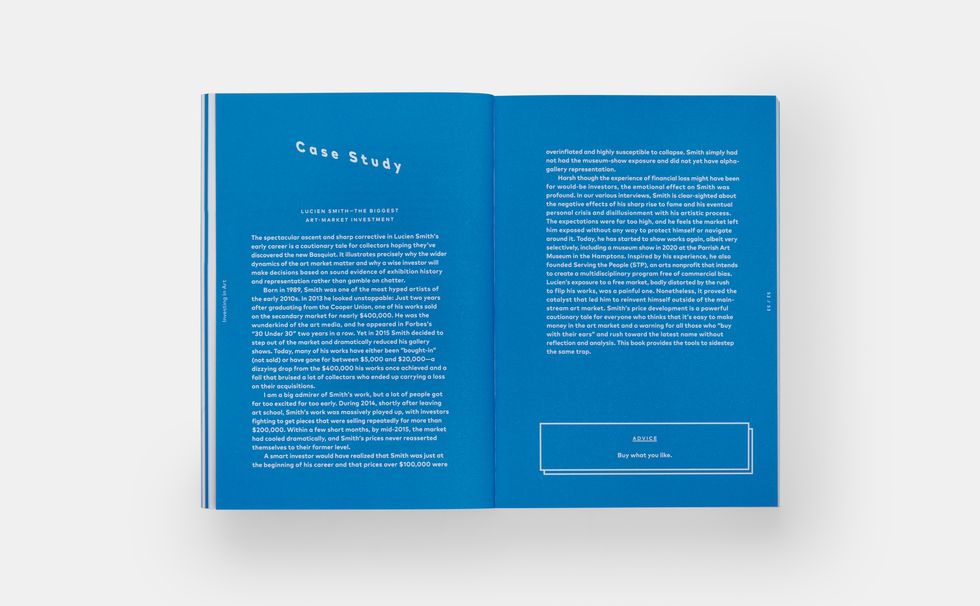
Artists
While some artists put their work up on artist platforms, many don’t. As a result, the best way to connect with them is via Instagram. I cannot emphasize this strongly enough: start following the accounts of the artists you see and like. This has two benefits. First, a lot of artists will share invites to their shows on Instagram. They will also post updates on their work and progress in their stories, which is all part of beginning to inhabit the art world you are entering, albeit in a different role. I personally connect with artists through Instagram almost daily to keep myself informed about shows I should attend. The second benefit is that the Instagram algorithm will suggest other artists and accounts you should follow.
I have devoted an entire chapter to artists in this book, which will help you to identify artists you should follow and buy. Don’t be deterred by distance either — even if an artist is in a different city or country, art shipping has become much easier. I frequently buy from other continents via Instagram and have them shipped via Fedex to me.
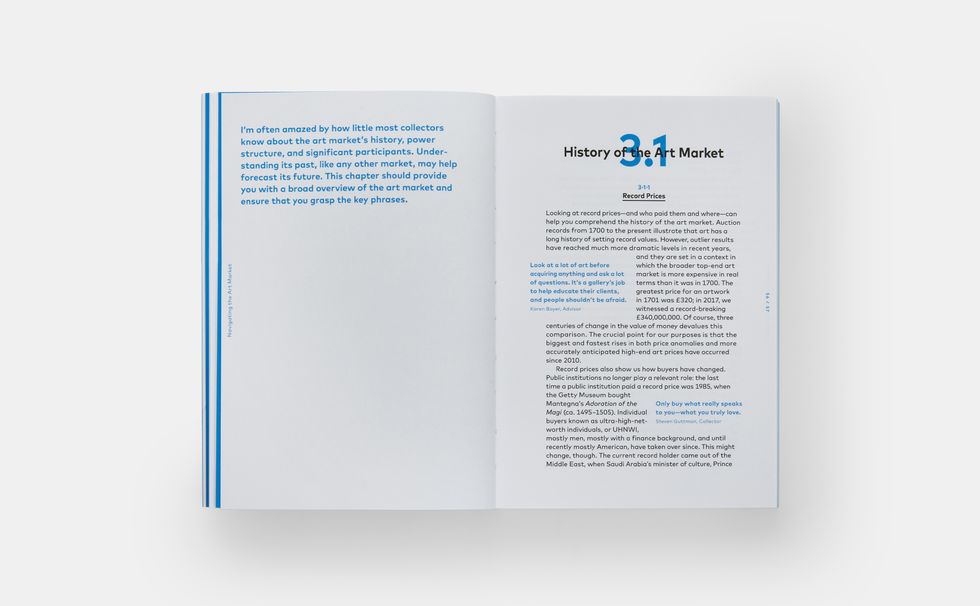
Collectors, Advisors and Curators
If your Instagram initially seems to offer frustratingly little art, the balance will shift just a few days after you start to follow collectors, advisors, and curators. Your best starting point is to follow a company that I cofounded, @larrys_list, straightaway. Every day our team posts photos of collectors’ homes, showing you how other collectors live and what art they are buying. I use this for inspiration (and must admit that I also like to see other people’s decor, right down to the wall color and carpets). Following other collectors, advisors, and curators helps me to narrow down my search for new artists because I can see what other people are looking at and what they collect. Striking out in an original direction purely because it is original is not a strategy I would advise at this point: unless you have a real passion for a particular artist, take your lead from experienced collectors.
And for those who are really into hunting down the next superstar artists, a recent study, which Larry’s List coauthored, showed that “likes” of certain collectors are solid indicators of future success for the artists. So if you are an aspiring investor collector, it is doubly important to follow collectors’ accounts to see what they are looking at. We will discuss collectors in a dedicated chapter in this book.
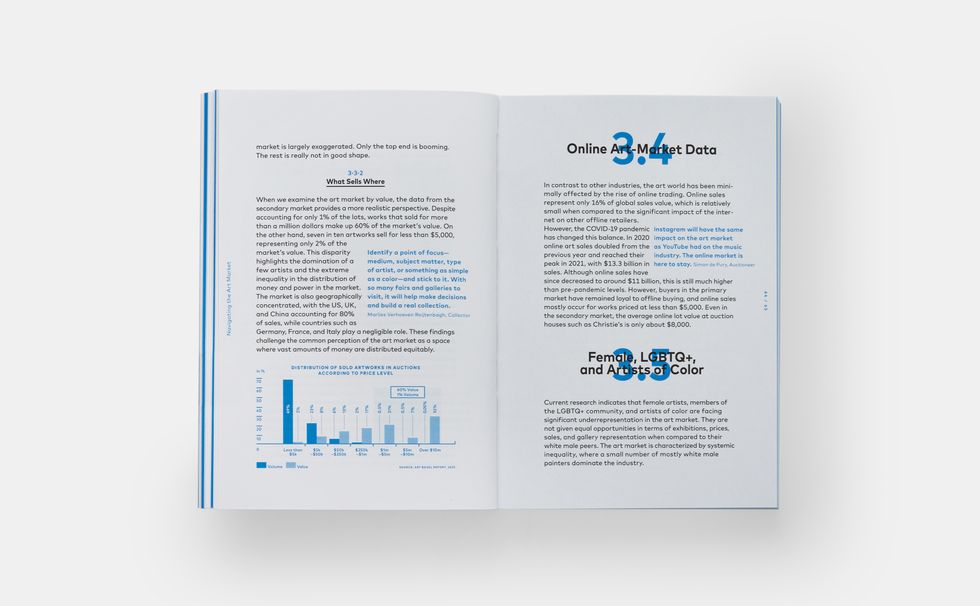
Art Fairs
Going to galleries can be draining, particularly in a large city. Art fairs, on the other hand, are the shopping malls of the art world. You find hundreds of galleries from around the world grouped under one roof. Over three hundred art fairs take place every year, and one will be close to where you are. I recommend that every starting collector go to art fairs as early as possible. It’s the easiest way for you to see a lot of art in a short time. In the chapter “Art Fairs,” we will discuss how to differentiate them and how to get the best out of them once you are there.
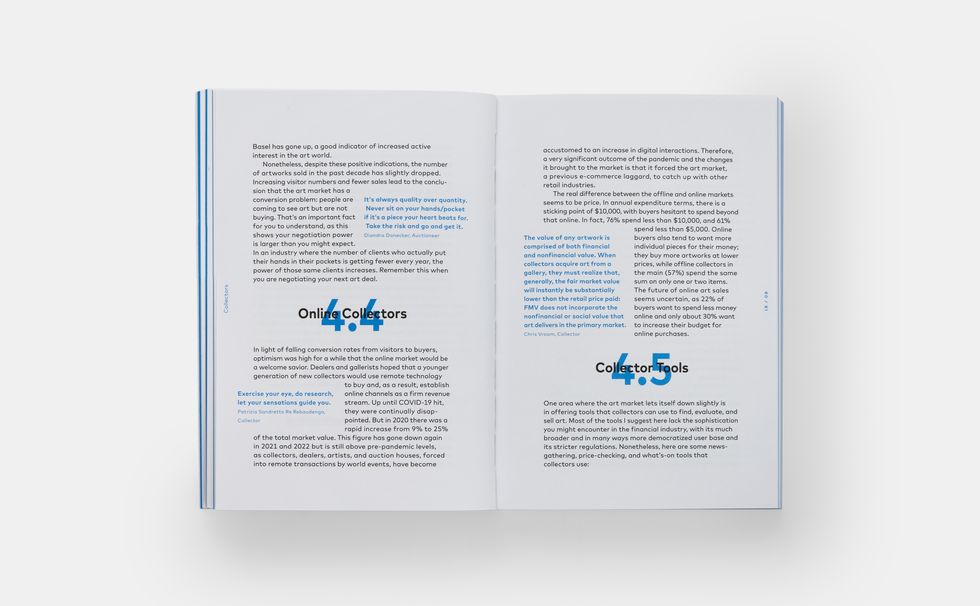
Auction Houses
In the past, only experienced buyers bought at auction, but they now attract a much more mainstream market. Auction houses have done a good job of opening the art trade to a wider audience. Auction launches are not unlike gallery openings in their party presentation. So don’t hesitate to go, even if you are not buying or only have a small budget. Auction houses may have — and to some extent have fostered — an exclusive and high-end reputation, but in reality over 90% of all artworks sold at auction go for under $10,000. A lot of auctions also focus on the low-end segment of the market. The terminology and mechanisms of auction houses, with things that you should be aware of, are all discussed in the “Auction House” chapter.
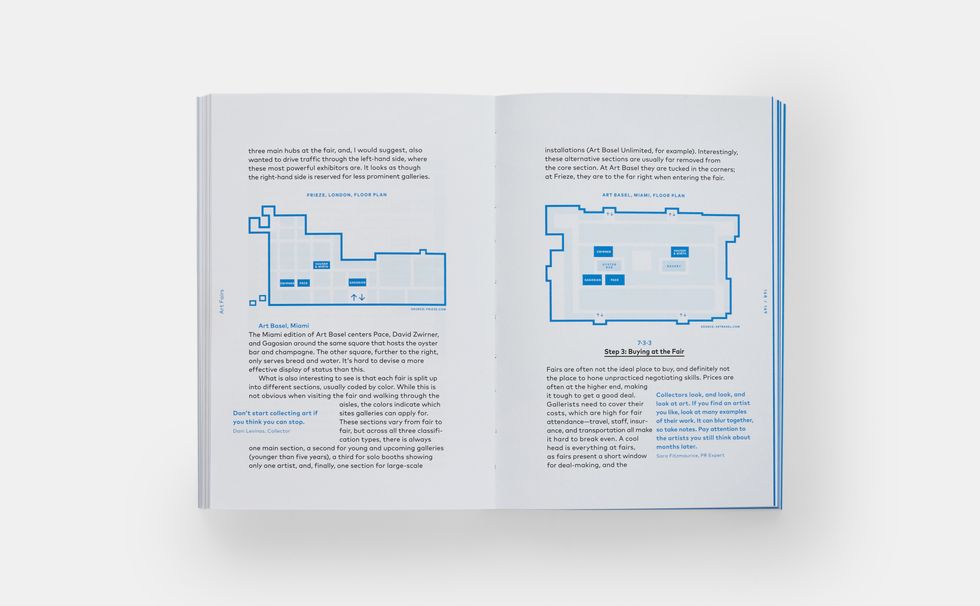
Collectors' Clubs
From all the different options above, for me, the best way to find new art is always through other collectors. Larry’s List is invaluable here, but I also make good use of collectors’ clubs. Wherever I lived, I have joined one of these circles that brings together new and experienced collectors and people interested in art: New York’s Guggenheim Young Collectors Council, the Freunde der Nationalgalerie in Berlin, the Tate Modern membership in London, the Bass membership in Miami and so many more. Start looking for collector groups in your city. I have always been surprised by the quality and effort the hosts put in, and, with a yearly membership usually costing less than $1,000, it’s affordable.
The real value of these groups is the monthly events, during which you might have the opportunity to hear a museum curator, for example, sharing their insights into the market, a new perspective on an artist you may not have really appreciated before, or an understanding of trends — you cannot put a price on hearing this kind of expertise firsthand. Private collector visits or artist studio visits are also great for new buyers. And, of course, networking with other collectors in the group will at some point pay dividends. You don’t need to be a collector to join a group — they are open to everyone. And my pro tip here would be: always look for a collector group that is affiliated with a museum. They usually have the best access to artists and to an international network.
Now that we’ve had this swift tour through the virtual and physical locations for seeing art, I’m now going to return to what I said initially. There are two things you need to do: see art and talk to as many people as possible. The art world is all about networking, but it’s also all about the love that people have for art. People love telling their stories. They love to share excitement about a piece of art, and they love to invite you to their events, talk about their collections, and so on. Once you start building a network, invitations to events and private homes will follow.
How to Collect Art by Magnus Resch is out January 31 and available to pre-order, here.
Photos courtesy of Magnus Resch
MORE ON PAPER
Entertainment
Rami Malek Is Certifiably Unserious
Story by Joan Summers / Photography by Adam Powell
Story by Joan Summers / Photography by Adam Powell
14 November
Music
Janelle Monáe, HalloQueen
Story by Ivan Guzman / Photography by Pol Kurucz/ Styling by Alexandra Mandelkorn/ Hair by Nikki Nelms/ Makeup by Sasha Glasser/ Nails by Juan Alvear/ Set design by Krystall Schott
Story by Ivan Guzman / Photography by Pol Kurucz/ Styling by Alexandra Mandelkorn/ Hair by Nikki Nelms/ Makeup by Sasha Glasser/ Nails by Juan Alvear/ Set design by Krystall Schott
27 October
Music
You Don’t Move Cardi B
Story by Erica Campbell / Photography by Jora Frantzis / Styling by Kollin Carter/ Hair by Tokyo Stylez/ Makeup by Erika LaPearl/ Nails by Coca Nguyen/ Set design by Allegra Peyton
Story by Erica Campbell / Photography by Jora Frantzis / Styling by Kollin Carter/ Hair by Tokyo Stylez/ Makeup by Erika LaPearl/ Nails by Coca Nguyen/ Set design by Allegra Peyton
14 October
Entertainment
Matthew McConaughey Found His Rhythm
Story by Joan Summers / Photography by Greg Swales / Styling by Angelina Cantu / Grooming by Kara Yoshimoto Bua
Story by Joan Summers / Photography by Greg Swales / Styling by Angelina Cantu / Grooming by Kara Yoshimoto Bua
30 September
Music
Demi Lovato Is No Joke
Story by Ivan Guzman / Photography by Jason Renaud / Styling by Chris Horan/ Makeup by Loftjet / Set design by Allegra Peyton
Story by Ivan Guzman / Photography by Jason Renaud / Styling by Chris Horan/ Makeup by Loftjet / Set design by Allegra Peyton
15 September

